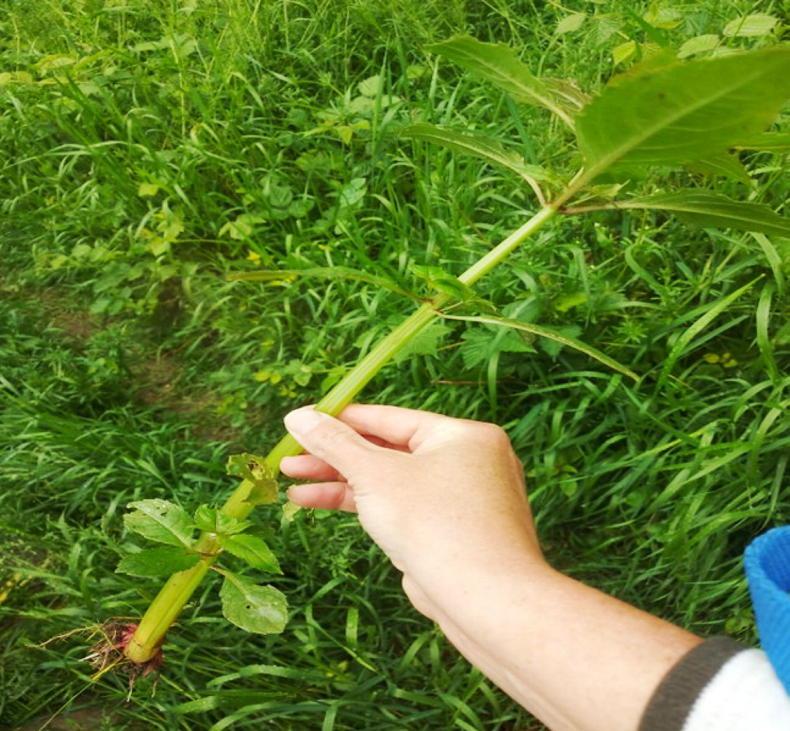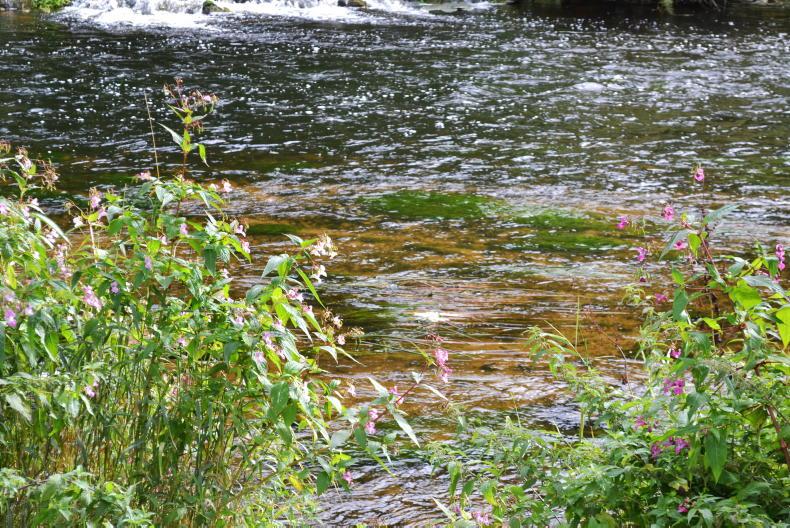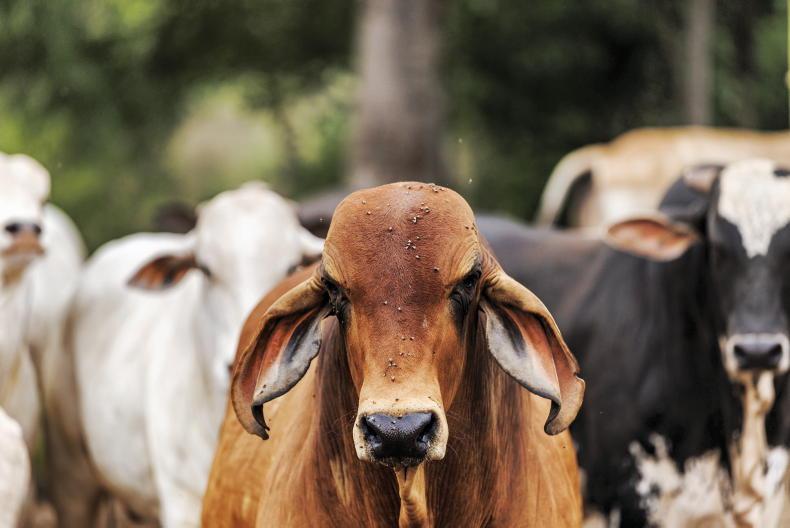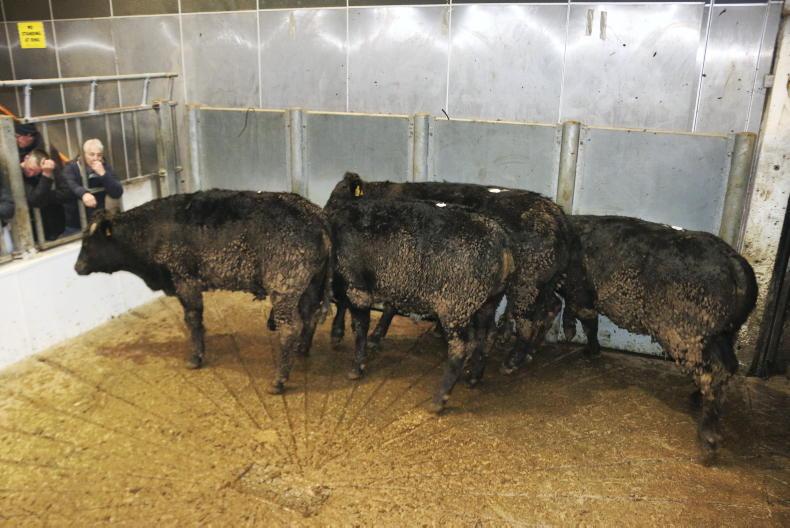The Nore River Catchment Trust (also known as Nore Vision) is calling on farmers, landowners, anglers and hikers along the river to be on the lookout for an invasive species known as Himalayan Balsam and report it to the organisation if any is found.

The stems of the young Himalayan Balsam plant grow upright, are easily broken and usually purplish in colour with large oval-shaped leaves
A "catchment" refers to a river and any of its tributaries or draining bodies. The River Nore is most often associated with Co Kilkenny, but the catchment of the river system runs from the Devil's Bit in Co Tipperary through counties Laois and Kilkenny before joining the River Barrow and draining into the sea in Co Waterford. According to the Nore River Catchment Trust's website, the Nore drains approximately 2,540 square kilometers of Leinster and Munster. The main land use associated with the river is agricultural and predominantly dairy and beef farming.
Himalayan Balsam
You might have seen Himalayan Balsam at some point and stopped to admire its attractive white, pink or purple flowers. Like many invasive species within Ireland, this plant was brought from its namesake region, the western Himalayas, to Ireland by the British aristocracy during the Victorian Era. Nore River Catchment Trust Project Leader, Mags Morrissey, says its beginnings in Ireland were innocent.

Himalayan Balsam is an invasive species; first brought to Ireland during the Victorian era
"They were initially in gardens as ornamental plants and, at some stage, escaped into the wild. Slowly but surely, they became widely established along rivers and streams," she explains.
Environmental impact
Mags tells Irish Country Living that the presence of Himalayan Balsam along the banks of the Nore presents two distinct problems. The first is to do with its dominance over other native species.
"The plant tends to dominate large areas and, as it grows up to six feet tall, it can easily block out native species," she says.
The other issue is its shallow root system.
"In winter, the plant dies back - leaving only its very small root system, which does nothing to stabilize the river bank. This exposes it to erosion."
Invasive species project
The prevalence of Himalayan Balsam along the Nore catchment area has been a main driver of the trust's ongoing Invasive Species project, which has delivered training on invasive species throughout the catchment area in the past several years. They are currently mapping Himalayan Balsam through the catchment to help effectively manage the species. They also educate on the prevalence of another invasive plant species, Giant Hogweed.
"Nore Vision has been involved in creating awareness and delivering training in relation to invasive species for a number of years, with a particular focus on Himalayan Balsam in Kilkenny," Mags says. "As this plant is so prolific, we are continuing to enable communities and landowners to actively manage the plant."
Management
While this species is found all along the Nore catchment, it is relatively easy to remove - you just need to do it at the right time. The plants are harmless (unlike Giant Hogweed, which causes serious skin irritation and should not be touched) and can be easily pulled from the ground by hand, thanks to its shallow root system.
"Once the root is exposed the plant will soon die," Mags explains. "However, this must be done before the seeds appear around July."
The Nore Vision group is available to assist landowners through training and linking with community volunteers, who can help with the removal of plants.
"We will work with volunteers and communities to coordinate the removal of the plants in accordance with guidelines from the National Parks and Wildlife Service," Mags says.
If you find Himalayan Balsam on your land or along the riverbank, contact Mags via email (mags@norevision.ie) or visit norevision.ie for more information.
The Nore River Catchment Trust (also known as Nore Vision) is calling on farmers, landowners, anglers and hikers along the river to be on the lookout for an invasive species known as Himalayan Balsam and report it to the organisation if any is found.

The stems of the young Himalayan Balsam plant grow upright, are easily broken and usually purplish in colour with large oval-shaped leaves
A "catchment" refers to a river and any of its tributaries or draining bodies. The River Nore is most often associated with Co Kilkenny, but the catchment of the river system runs from the Devil's Bit in Co Tipperary through counties Laois and Kilkenny before joining the River Barrow and draining into the sea in Co Waterford. According to the Nore River Catchment Trust's website, the Nore drains approximately 2,540 square kilometers of Leinster and Munster. The main land use associated with the river is agricultural and predominantly dairy and beef farming.
Himalayan Balsam
You might have seen Himalayan Balsam at some point and stopped to admire its attractive white, pink or purple flowers. Like many invasive species within Ireland, this plant was brought from its namesake region, the western Himalayas, to Ireland by the British aristocracy during the Victorian Era. Nore River Catchment Trust Project Leader, Mags Morrissey, says its beginnings in Ireland were innocent.

Himalayan Balsam is an invasive species; first brought to Ireland during the Victorian era
"They were initially in gardens as ornamental plants and, at some stage, escaped into the wild. Slowly but surely, they became widely established along rivers and streams," she explains.
Environmental impact
Mags tells Irish Country Living that the presence of Himalayan Balsam along the banks of the Nore presents two distinct problems. The first is to do with its dominance over other native species.
"The plant tends to dominate large areas and, as it grows up to six feet tall, it can easily block out native species," she says.
The other issue is its shallow root system.
"In winter, the plant dies back - leaving only its very small root system, which does nothing to stabilize the river bank. This exposes it to erosion."
Invasive species project
The prevalence of Himalayan Balsam along the Nore catchment area has been a main driver of the trust's ongoing Invasive Species project, which has delivered training on invasive species throughout the catchment area in the past several years. They are currently mapping Himalayan Balsam through the catchment to help effectively manage the species. They also educate on the prevalence of another invasive plant species, Giant Hogweed.
"Nore Vision has been involved in creating awareness and delivering training in relation to invasive species for a number of years, with a particular focus on Himalayan Balsam in Kilkenny," Mags says. "As this plant is so prolific, we are continuing to enable communities and landowners to actively manage the plant."
Management
While this species is found all along the Nore catchment, it is relatively easy to remove - you just need to do it at the right time. The plants are harmless (unlike Giant Hogweed, which causes serious skin irritation and should not be touched) and can be easily pulled from the ground by hand, thanks to its shallow root system.
"Once the root is exposed the plant will soon die," Mags explains. "However, this must be done before the seeds appear around July."
The Nore Vision group is available to assist landowners through training and linking with community volunteers, who can help with the removal of plants.
"We will work with volunteers and communities to coordinate the removal of the plants in accordance with guidelines from the National Parks and Wildlife Service," Mags says.
If you find Himalayan Balsam on your land or along the riverbank, contact Mags via email (mags@norevision.ie) or visit norevision.ie for more information.














SHARING OPTIONS